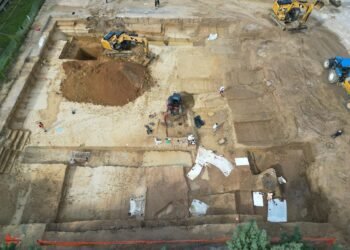Archaeologists from the French National Institute for Preventive Archaeological Research (INRAP) have uncovered a 1,900-year-old Roman tile production workshop on the east coast of Corsica, near the Étang de Diane lagoon. The discovery was made ahead of a real estate development.

Excavations, which began in July, revealed evidence of human occupation dating back to the Early Iron Age. Archaeologists uncovered about 50 structures, some built with stone and others with perishable materials, such as wood, indicated by surviving post holes. The site yielded local ceramic artifacts, imported Etruscan pottery, and macrolithic tools such as millstones and grinding wheels. Pits filled with charcoal remains, broken vessels, and fragmented tools suggest domestic activities, while pebble formations likely represent building foundations.
This prehistoric settlement predates the Roman occupation and extends beyond the current excavation area, limiting the full understanding of its layout.
To the south of the prehistoric site, near the water’s edge, a comprehensive Roman tile production workshop was unearthed. According to INRAP, the site showcases all stages of production. Clay was first decanted in a large basin made of tiles (tegulae), with a diameter of 14 feet (4.3 meters). The processed clay was then shaped and fired in a kiln featuring a double-vaulted heating chamber. This kiln was housed within a large structure constructed with pebbles embedded in lime mortar.

Adjacent to the kiln, archaeologists discovered a warehouse, supported by buttresses, that likely stored finished tiles. Outside these structures, pits containing kiln waste and misfired tiles were identified. Additionally, a road leading to the workshop hints at its connectivity and the transport of goods.
Corsica came under Roman control in 163 BCE after prolonged military campaigns. Britannica notes that under Roman rule, the island’s economy thrived, and the Roman language heavily influenced the local dialect, shaping the modern Corsican language.

The tile workshop, dated to the first century CE, reflects the Roman industrial presence on the island. The craftsmanship and scale of the production suggest a robust local economy during the period.
At the outskirts of the workshop, archaeologists discovered eight graves. Most were constructed with tiles and stone, but one was a pottery urn, which may contain cinerary remains. Due to the acidic soil, skeletal remains did not survive. However, grave goods such as ceramic vessels and glass balsamaria were found. These burials likely coincide with the tile workshop’s operational period and will be analyzed further to confirm their dates.

While the excavation will conclude in December to allow real estate development, the archaeological materials will be studied in 2025. A multidisciplinary team of ceramologists, anthropologists, and other experts will examine the findings. Laboratory analysis will refine the dating of the graves and explore the site’s broader significance.
More information: Inrap


























